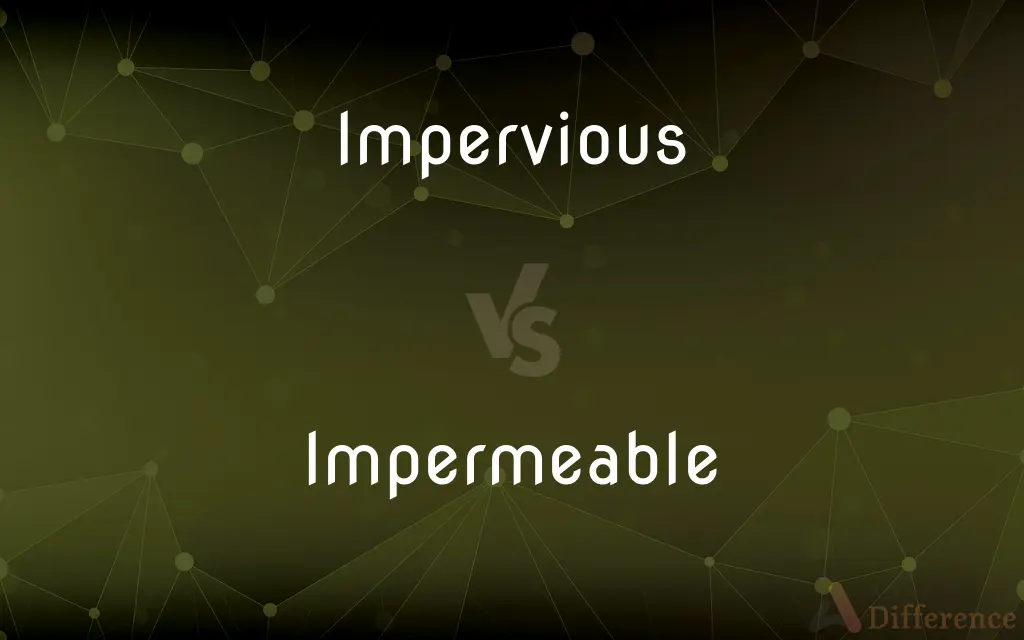Impervious vs. Impermeable — What's the Difference?
By Tayyaba Rehman & Fiza Rafique — Updated on March 27, 2024
Impervious surfaces resist penetration by water due to their structure, like concrete, while impermeable materials, such as rubber, do not allow fluids to pass through at the molecular level.

Difference Between Impervious and Impermeable
Table of Contents
ADVERTISEMENT
Key Differences
Impervious surfaces, such as concrete sidewalks and asphalt roads, are designed to withstand penetration by water and other substances, primarily due to their dense composition and construction. This makes them ideal for urban infrastructure, where water runoff management is crucial. On the other hand, impermeable materials like rubber or certain plastics are characterized by their molecular structure that prevents any fluids from passing through, making them suitable for waterproofing applications in various industries.
While impervious surfaces are effective in preventing water absorption on a macro scale, they can contribute to urban runoff and flooding, as water cannot penetrate through them into the ground. Impermeable materials, however, are used to create barriers against moisture and liquids in products such as raincoats, waterproof bags, and sealing materials, showcasing their utility in preventing liquid infiltration on both macro and micro scales.
The concept of imperviousness is often applied in the context of environmental planning and construction, emphasizing the surface's resistance to water and its implications for natural water cycles and urban drainage systems. Impermeability, however, is a term more frequently used in materials science and engineering, focusing on the ability of a material to completely block the passage of liquids and gases through its structure.
Impervious surfaces are generally considered in terms of their impact on surface water flow, highlighting concerns such as increased runoff and reduced groundwater recharge. Conversely, the use of impermeable materials is crucial in applications where preventing the passage of substances is vital for safety, hygiene, or preservation, such as in medical gloves or food packaging.
The maintenance and environmental impact of impervious surfaces are significant, often requiring management strategies to mitigate effects like stormwater runoff pollution. In contrast, impermeable materials are valued for their durability and protective qualities, but their environmental impact, particularly in terms of disposal and recycling, is also a concern, indicating the complexity of their roles in sustainable practices.
ADVERTISEMENT
Comparison Chart
Definition
Resistant to penetration by water
Not allowing fluids to pass through
Primary Use
Urban infrastructure (roads, sidewalks)
Waterproofing (clothing, materials)
Impact
Contributes to runoff and flooding
Prevents liquid infiltration
Context
Environmental planning, construction
Materials science, engineering
Environmental Concern
Runoff pollution, groundwater recharge
Disposal, recycling challenges
Compare with Definitions
Impervious
Not allowing fluid to pass through.
They used an impervious cover to protect the outdoor furniture.
Impermeable
Completely resistant to passage of water molecules.
Impermeable gloves are essential for chemical handling.
Impervious
Unable to be penetrated by water.
The impervious layer of the roof prevents leaks.
Impermeable
Unable to be breached or penetrated.
The safe was made from impermeable steel.
Impervious
Not admitting of passage or capable of being affected;
A material impervious to water
Someone impervious to argument
Impermeable
Impenetrable by substances.
The container is impermeable to air, keeping food fresh.
Impervious
Impermeable by a particular substance.
The coating makes the fabric impervious to stains.
Impermeable
Not allowing fluid to pass through.
The impermeable membrane protects the building from water damage.
Impervious
Unresponsive or insensitive to.
She was impervious to their criticism.
Impermeable
Sealed against entry of liquids.
They wore impermeable suits in the rainstorm.
Impervious
Resistant to being affected by.
He seemed impervious to the cold.
Impermeable
Impossible to permeate
An impermeable membrane.
An impermeable border.
Impervious
Not allowing fluid to pass through
An impervious layer of basaltic clay
Impermeable
Impossible to permeate.
Impervious
Unable to be affected by
He worked, apparently impervious to the heat
Impermeable
Not allowing passage, especially of liquids; waterproof.
Impervious
Incapable of being penetrated
A material impervious to water.
Impermeable
Not permeable; not permitting passage, as of a fluid. through its substance; impervious; impenetrable; as, India rubber is impermeable to water and to air.
Impervious
Incapable of being affected
Impervious to fear.
Impermeable
Preventing especially liquids to pass or diffuse through;
Impermeable stone
An impermeable layer of scum
A coat impermeable to rain
Impervious
Unaffected or unable to be affected by something.
The man was completely impervious to the deception we were trying.
Impervious
Preventive of any penetration; impenetrable, impermeable, particularly of water.
Although patchworked and sagging, the roof proved impervious to the weather.
Impervious
Immune to damage or effect.
The old car seemed to be impervious to the wear and tear of age.
Impervious
Not pervious; not admitting of entrance or passage through; as, a substance impervious to water or air.
This gulf impassable, impervious.
The minds of these zealots were absolutely impervious.
Common Curiosities
How are impermeable materials used in everyday products?
They are used in waterproof clothing, containers, and seals to prevent the passage of water and other substances.
Are all impervious surfaces harmful to the environment?
While not inherently harmful, impervious surfaces can contribute to environmental issues like runoff and reduced groundwater recharge.
Can impermeable materials let any substances through?
No, impermeable materials do not allow any substances, including liquids and gases, to pass through.
How does the maintenance of impervious surfaces impact water quality?
Improper maintenance can lead to pollution in runoff, affecting water quality in nearby bodies of water.
What is the difference between waterproof and impermeable?
Waterproof implies resistance to water penetration under certain conditions, while impermeable means no water can pass through under any condition.
What makes a surface impervious?
A surface is impervious if it is constructed or treated in a way that does not allow water to penetrate it.
Is asphalt considered impervious or impermeable?
Asphalt is considered impervious because it prevents water penetration but may not be completely impermeable at the molecular level.
Can impermeable materials be breathable?
Yes, some impermeable materials are engineered to be breathable, allowing vapor to pass through while blocking liquids.
What role do impervious surfaces play in urban planning?
They are critical in designing infrastructure that manages water runoff, but require careful planning to mitigate environmental impacts.
Are there eco-friendly alternatives to impermeable materials?
Yes, there are eco-friendly materials that are impermeable to water yet more sustainable and easier to recycle.
Can a material be both impervious and breathable?
Yes, advanced materials technology has created fabrics that are water-resistant yet allow moisture vapor from sweat to escape.
What measures can reduce the environmental impact of impervious surfaces?
Implementing green infrastructure like permeable pavements and green roofs can help mitigate the impact.
How does impermeability affect the lifespan of products?
It can greatly extend the lifespan by protecting against moisture and other damaging substances.
Why is impermeability important in medical applications?
It prevents the transmission of fluids and pathogens, ensuring safety and hygiene in medical settings.
Can impervious surfaces be made more environmentally friendly?
Yes, through the use of materials and designs that allow some water infiltration or direct runoff to sustainable drainage solutions.
Share Your Discovery

Previous Comparison
Discretion vs. Discrimination
Next Comparison
Serious vs. SincereAuthor Spotlight
Written by
Tayyaba RehmanTayyaba Rehman is a distinguished writer, currently serving as a primary contributor to askdifference.com. As a researcher in semantics and etymology, Tayyaba's passion for the complexity of languages and their distinctions has found a perfect home on the platform. Tayyaba delves into the intricacies of language, distinguishing between commonly confused words and phrases, thereby providing clarity for readers worldwide.
Co-written by
Fiza RafiqueFiza Rafique is a skilled content writer at AskDifference.com, where she meticulously refines and enhances written pieces. Drawing from her vast editorial expertise, Fiza ensures clarity, accuracy, and precision in every article. Passionate about language, she continually seeks to elevate the quality of content for readers worldwide.
















































